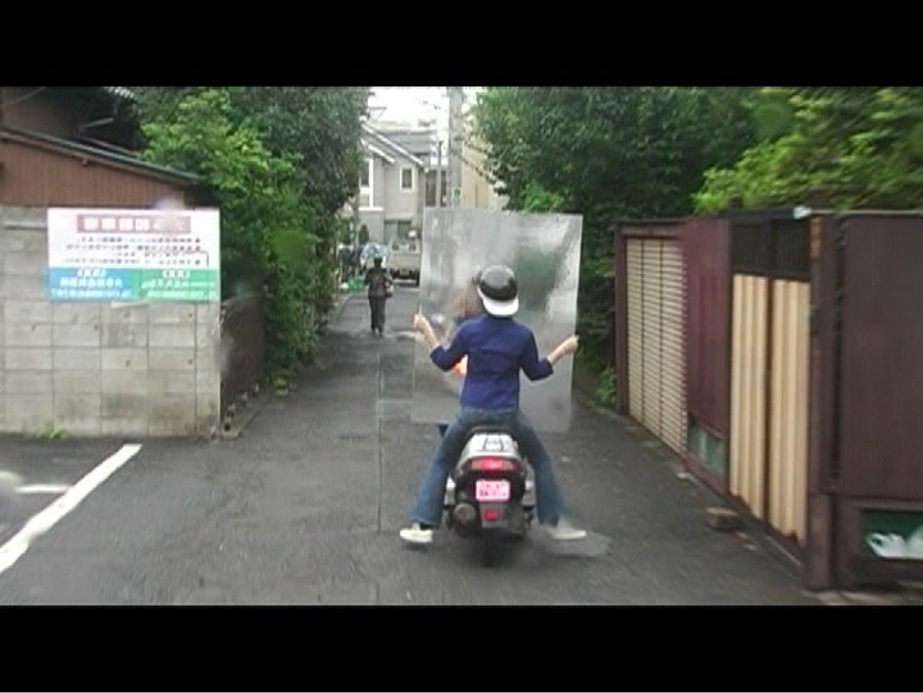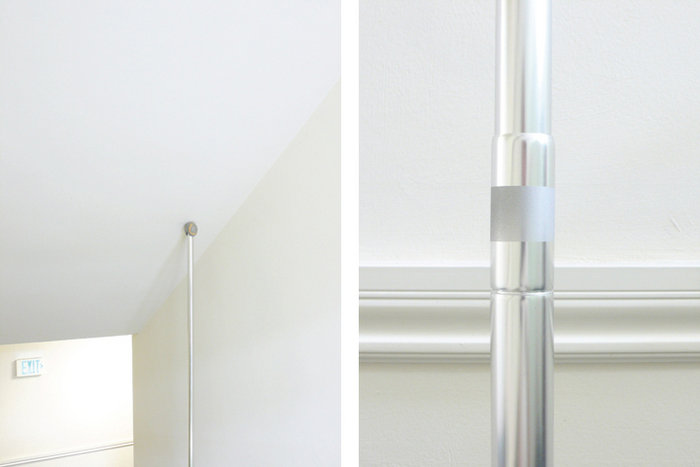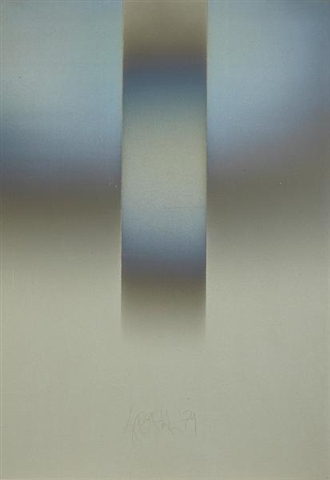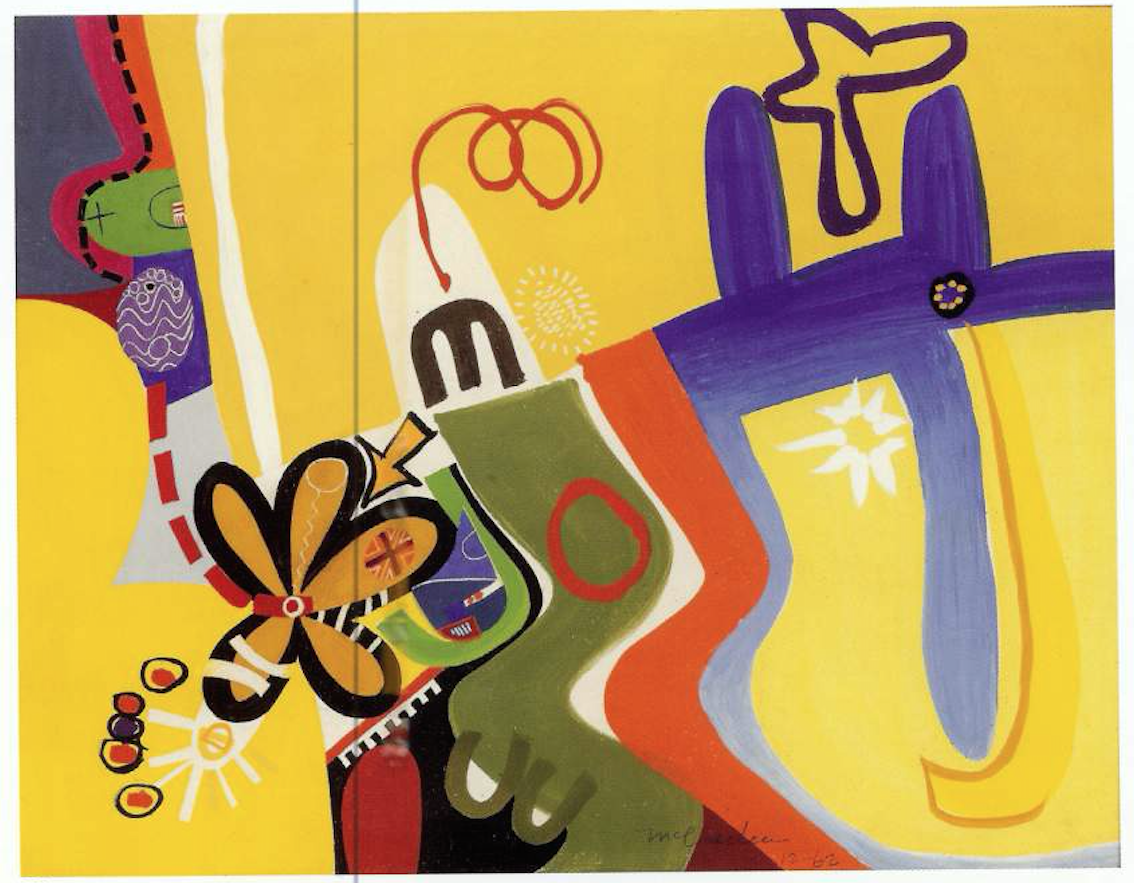
© » KADIST
Will Rogan
Drawing & Print (Drawing & Print)
MUM , the acronym used to title a series of Rogan’s small interventions on found magazines, stands for “Magic Unity Might,” the name of a vintage trade magic publication. In the series, Rogan alters the magazine’s pages by erasing the image of the magicians doing their tricks, leaving only the background of their performances on view. These contexts range from the more overtly staged scenario in Silencer #16 —the erased magician is about to perform a trick on his assistant trapped on an odd, almost dada looking box—to the more “colloquial” Silencer #17 in which the absent magician’s silhouette appears in what seems to be a children’s hospital.

© » KADIST
Aaron Young
The artist describes the work as “very performative video-pieces but they take on a more sculptural feel. The action is simple: I kick a video camera through a site that is embedded with sociological elements, which I try to question through my practice. I chose Red Square as the site to work in Moscow.

© » KADIST
Will Rogan
Shot in the streets of Tokyo, Collapse , is a meditation on the passing of time and on the complicated way in which we are smashed between the past and the future. The video follows a moped carrying a woman holding a very large mirror. The mirror is large enough that she can’t see what lies ahead, she can only see what has already come as reflections in the mirror.

© » KADIST
Gimhongsok
To explore the boundaries between artwork and audience, Gimhongsok created a series of sculptural performances in which a person wearing an animal costume poses in the gallery. Bunny’s Sofa is a continuation of this series, but with a different twist. Instead of hiring a real person to dress as the animal, Gimhongsok placed a mannequin inside the rabbit costume.

© » KADIST
Julian Hoeber
Every work in Hoeber’s 2011 series Execution Changes is titled in alphanumeric code. The geometric pattern that composes each acrylic-on-panel painting is determined by a preordained ratio of 2 to 3. But even though a formulaic system determines the image’s structure, its surface is full of painterly effects.

© » KADIST
Paul Kos
Parked on the shoulder of a single lane highway running through a desert landscape, Marlene looks over her shoulder from inside the car at a fierce storm looming over a distant horizon. Turning her head toward and away from the scene she says, “When I look for the lightning it never strikes, but when I look away it does.” And indeed, the lightning does seem to strike only when she turns away. Before filming Lightning , Paul Kos had done a fair amount of research on lightning, much of it conducted at the lightning research lab at the University of Colorado.

© » KADIST
Paul Kos
Sound of Ice Melting is based on the ancient Zen Buddhist koan about the sound of one hand clapping. Here, Kos has surrounded two twenty-five-pound blocks of ice with eight microphones that call to mind the political press conferences prevalent during the Vietnam War era when this piece was created. Zen practice values such absurdity as a way to transcend the limitations of ordinary discourse and rational thought—empirical processes at the root of all political conflicts.

© » KADIST
Will Rogan
Will Rogan’s video Eraser (2014) shows a hearse parked in a clearing amidst leaf barren trees. The steely grey sky stands in stark contrast to the vehicle’s luminously pristine white finish and makes this already deathly object seem even more ghostly. The grass underneath is half-turned brown and further marks this as a lifeless landscape.

© » KADIST
Alexandre da Cunha
Glaze (Savana) (2005) is an assemblage of found materials: a car wheel, a tire, and a wooden plinth of the type traditionally used to display sculpture. It directly engages with the readymade, a subject that Alexandre de Cunha takes up throughout his practice, often inflecting it with a tropical, and South American–inspired materiality and painterly style that could potentially come across as a stereotype. Here, da Cunha transforms the component parts into a composition that highlights often-overlooked materials of artistic production and cultural mass-production.

© » KADIST
Alexandre da Cunha
The series West (Flag 1), West (Flag 3), and West (Flag 6) continues da Cunha’s ongoing exploration of the form’s various vertical, horizontal, and diagonal stripes. Here, da Cunha overlays thick bars of color (blue, green, and red) on photographs of the ocean at sunset with surfers in floating on the horizon. The solid colors contrast with the fading colors reflected in the sunset, and the tilted orientation suggests a familiar California beach scene.

© » KADIST
Alexandre da Cunha
In Laissez-Faire (Rainbow Flag) da Cunha has turned a beach towel into both a painting and a flag. Where the printed surface of the towel originally served to enliven this commodity, here the pattern—now stretched and re-presented—suddenly refers to abstract painting’s promises of transcendence. And its crisply painted shape pulls the printed colors into the rectangularity of the canvas and, as da Cunha notes, the graphic iconicity of flags.

© » KADIST
Kate Gilmore
In the six-minute single-channel video Higher Horse , Kate Gilmore perches herself on top of a tall pile of plaster blocks, in front of a pink colored wall with vein-like streaks of red. Two muscular men with sledgehammers simultaneously pummel the blocks where Gilmore attempts to stand. Although we can only see the artist from the waist down, her body language reveals apprehension: her hands, tense, press against the wall in an attempt to maintain balance while the men come dangerously close to smashing her bare legs.

© » KADIST
Chadwick Rantanen
Telescopic Pole is an adjustable telescopic pole that extends vertically from floor to ceiling and is held up by its own internal pressure. The ends, protected by two, cut-open tennis balls, recall the legs of a walker. For Rantanen’s second solo exhibition at Jancar Jones Gallery, San Francisco in 2010, one pole was placed inside the gallery while the other was located outside.

© » KADIST
Paul Kos
Taking its title from the eponymous mythological creature—famously featured as sea nymphs in Homer’s Odyssey. Sirens exist in literature across many cultures including Ancient Greece and India, described as part bird and part woman, or like a mermaid. They were said to charm men by their song, and, having first lulled them to sleep, tear them to pieces.

© » KADIST
Alexandre da Cunha
His Deck Painting I recalls the simplistic stripes of conceptual artist Daniel Buren, or the minimal lines of twentieth century abstract painting, but is in reality a readymade, fashioned from repurposed fabric of deck chairs. Alexandre da Cunha reinvents found objects in surprising ways that combine the material characteristics of Arte Povera with the concerns and techniques of painting. Da Cunha’s work often features flags—either as a found material per se or as a constructed form—that reflect the artist’s interest in issues of nationality, governmental politics, allegiance, and culture.

© » KADIST
Larry Bell
Drawing & Print (Drawing & Print)
Like many of Larry Bell’s works, VFGY9 deals primarily with the viewer’s experience of sight. The blocks resemble a stone carving, or slabs of wood shaped into a simple organic composition whose overall sheen is varied through a thin layer of aluminum vapor. Yet, the real material of Bell’s piece is actually light, formed within the viewer’s eye into masses as present as stone.

© » KADIST
Larry Bell
Untitled (Construction) recalls the series of glass cubes that gained Bell international recognition in the 1960s. Resembling a black-mirrored box, this recent iridescent piece produces an uncanny effect in which the interior planes seem to enclose a mysterious light. Although austere in form, Bell’s works are far from simple: he uses technology like a vacuum-coating process, to accurately control the different levels of opacity and transparency on the surface of his immaculate glass works.

© » KADIST
John McCracken
Though not strictly representational, some objects in Untitled (1962) are recognizable: a flower, an egg, a foot. The arrows and directional lines suggest movement, but the forms they point to intertwine, prohibiting a straightforward reading. The shapes are as illustrative as a Rorschach inkblot; in their confounding, simple indeterminacy, they depict nothing and everything at once.

© » KADIST
Mike Kelley
Towhead n’Ganga, enclosed in darkness, lorded over by the sexualized folded high priestless form reflects many of Kelley’s works, in both its compositional and semantic qualities. The drawing on wood, the popcorn mixture, and the title all manifest a bumpy fullness, a “more-is-more” conflation between supposedly eternal spirituality and everyday stuff. The work’s title points to a serious timelessness completely belied by the materials.
Paul Kos
- location: San Francisco, California
- year born: 1942
- gender: male
- nationality: American
Alexandre da Cunha
- location: London, United Kingdom
- year born: 1969
- gender: male
- nationality: Brazilian
- home town: Rio de Janeiro, Brazil
Will Rogan
- location: Albany, California
- year born: 1975
- gender: male
- nationality: American
Larry Bell
- location: Venice, California
- year born: 1939
- gender: male
- nationality: American
- home town: Chicago, Illinois
Mike Kelley
- location: Los Angeles, California
- year born: 1954
- gender: male
- nationality: American
- home town: Detroit, Michigan
Julian Hoeber
- location: Los Angeles, California
- year born: 1974
- gender: male
- nationality: American
- home town: Philadelphia, Pennsylvania
John McCracken
- year born: 1934
- gender: male
- nationality: American
- home town: Berkeley, California
Kate Gilmore
- location: New York, New York
- year born: 1975
- gender: female
- nationality: American
- home town: Washington, D.C.
Chadwick Rantanen
- location: Los Angeles, California
- year born: 1981
- gender: male
- nationality: American
- home town: Wausau, Wisconsin
-
1970-1979
Larry Bell
Drawing & Print
1979(Drawing & Print) Like many of Larry Bell’s works, VFGY9 deals primarily with the viewer’s experience of sight...
-
1990-1999
Mike Kelley
1996Towhead n’Ganga, enclosed in darkness, lorded over by the sexualized folded high priestless form reflects many of Kelley’s works, in both its compositional and semantic qualities...
-
2000-2009
Alexandre da Cunha
2005Glaze (Savana) (2005) is an assemblage of found materials: a car wheel, a tire, and a wooden plinth of the type traditionally used to display sculpture...
Alexandre da Cunha
2005His Deck Painting I recalls the simplistic stripes of conceptual artist Daniel Buren, or the minimal lines of twentieth century abstract painting, but is in reality a readymade, fashioned from repurposed fabric of deck chairs...
Aaron Young
2007The artist describes the work as “very performative video-pieces but they take on a more sculptural feel...
Will Rogan
2007Shot in the streets of Tokyo, Collapse , is a meditation on the passing of time and on the complicated way in which we are smashed between the past and the future...
Gimhongsok
2007To explore the boundaries between artwork and audience, Gimhongsok created a series of sculptural performances in which a person wearing an animal costume poses in the gallery...
Larry Bell
2007Untitled (Construction) recalls the series of glass cubes that gained Bell international recognition in the 1960s...
Kate Gilmore
2008In the six-minute single-channel video Higher Horse , Kate Gilmore perches herself on top of a tall pile of plaster blocks, in front of a pink colored wall with vein-like streaks of red...
-
2010-2019
Will Rogan
Drawing & Print
2010(Drawing & Print) MUM , the acronym used to title a series of Rogan’s small interventions on found magazines, stands for “Magic Unity Might,” the name of a vintage trade magic publication...
Alexandre da Cunha
2010In Laissez-Faire (Rainbow Flag) da Cunha has turned a beach towel into both a painting and a flag...
Chadwick Rantanen
2010Telescopic Pole is an adjustable telescopic pole that extends vertically from floor to ceiling and is held up by its own internal pressure...
Alexandre da Cunha
2011The series West (Flag 1), West (Flag 3), and West (Flag 6) continues da Cunha’s ongoing exploration of the form’s various vertical, horizontal, and diagonal stripes...
Julian Hoeber
2011Every work in Hoeber’s 2011 series Execution Changes is titled in alphanumeric code...
Will Rogan
2014Will Rogan’s video Eraser (2014) shows a hearse parked in a clearing amidst leaf barren trees...

